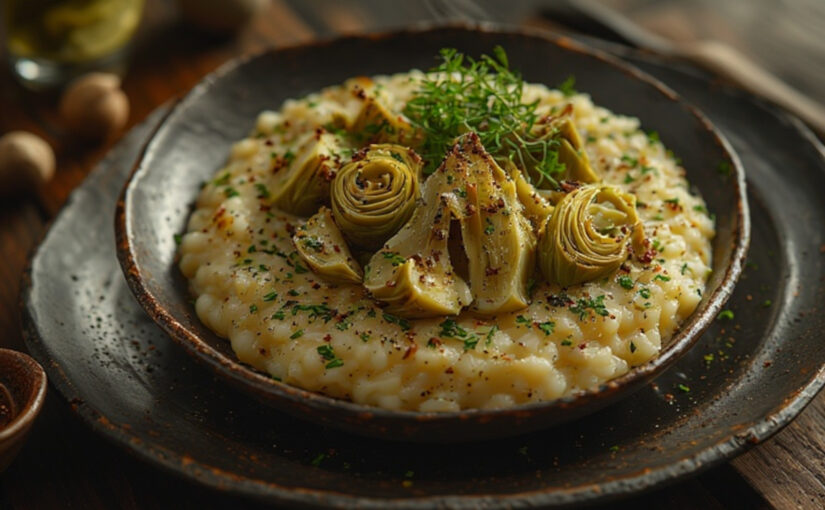There’s pure alchemy in watching risotto come together on the stovetop. Each grain of Arborio rice slowly surrenders its starch, transforming into velvety, spoonable perfection without any cream at all. When you fold in tender artichoke hearts, you’re creating something that embodies the soul of Italian springtime cooking. This is the kind of dish that feels both refined and deeply comforting, impressive yet wonderfully uncomplicated.
What makes artichoke risotto so beloved is its harmony of flavors. The artichokes contribute a gentle sweetness and silky bite, while aged Parmesan weaves in a rich, savory complexity that keeps you reaching for another spoonful. It’s fancy enough to serve at a dinner party but cozy enough to enjoy curled up on a Tuesday night with a glass of wine.
🍽️ Recipe Details
Serves: 4 people
Prep Time: 15 minutes
Cook Time: 30 minutes
🛒 Ingredients
For the Risotto:
- 1½ cups Arborio rice 🍚
- 6 cups vegetable or chicken stock (kept warm) 🥣
- 1 cup dry white wine 🍷
- 1 medium onion, finely diced 🧅
- 3 cloves garlic, minced 🧄
- 3 tablespoons olive oil 🫒
- 2 tablespoons butter 🧈
- ¾ cup freshly grated Parmesan cheese 🧀
- Salt and black pepper to taste
For the Artichokes:
- 10-12 ounces artichoke hearts (fresh, frozen, or canned in water) 💚
- 2 tablespoons olive oil
- Zest of 1 lemon 🍋
- 2 tablespoons fresh parsley, chopped 🌿
👨🍳 Preparation
Preparing the Artichokes
If using fresh artichokes, trim and cook them until tender, then quarter. For frozen, thaw and pat dry. For canned, drain and rinse well. Heat 2 tablespoons olive oil in a pan and sauté the artichoke hearts until golden, about 5-7 minutes. Season with salt, pepper, and lemon zest. Set aside.
Making the Risotto
Heat the stock in a separate pot and keep it at a gentle simmer. In a large, heavy-bottomed pan, heat 3 tablespoons olive oil over medium heat. Add the diced onion and cook until soft and translucent, about 5 minutes. Add the garlic and cook for another minute until fragrant.
Add the Arborio rice and stir continuously for 2-3 minutes until the grains are lightly toasted and coated in oil. You’ll hear a slight crackling sound, that’s perfect! 🎵
Pour in the white wine and stir until it’s almost completely absorbed. Now begins the rhythmic dance of risotto making. Add the warm stock one ladle at a time, stirring frequently. Wait until each addition is mostly absorbed before adding the next. This process takes about 18-20 minutes.
When the rice is creamy but still has a slight bite (al dente), fold in the sautéed artichokes, butter, and Parmesan cheese. Stir vigorously to create that luscious, creamy consistency. Taste and adjust seasoning with salt and pepper.
🍴 How to Serve
Serve immediately in warmed shallow bowls. The risotto should flow slightly when spooned, not sit in a stiff mound. Garnish generously with fresh parsley, extra Parmesan shavings, a drizzle of good quality olive oil, and a twist of black pepper.
Perfect Pairings: 🍷
A crisp Italian white wine like Pinot Grigio or Vermentino complements the artichokes beautifully. Serve alongside a simple arugula salad with lemon vinaigrette and crusty Italian bread for sopping up every last bit.
🏛️ From Ancient Delicacy to Modern Table: The Story of Artichoke Risotto
Long before artichoke risotto graced modern Italian menus, both of its star ingredients had already captured the imaginations of Mediterranean peoples. The artichoke, that architectural flower bud with its layered leaves, was prized by ancient Greeks and Romans who considered it a luxury food and an aphrodisiac. Roman aristocrats cultivated them in their gardens, and the vegetable eventually became deeply woven into Italian culinary identity, particularly in regions like Lazio and Sicily.
Risotto’s story is equally fascinating. While rice arrived in Italy during the Middle Ages through Arab trade routes and Spanish introductions, it found its perfect home in the fertile Po Valley of northern Italy. The Venetians and Milanese transformed this grain into something uniquely their own. By the Renaissance, risotto had become a staple of northern Italian cuisine, with each region developing its signature variations.
The marriage of artichokes and risotto likely emerged in the 19th century as Italian cuisine began codifying its regional dishes. Spring in Italy meant fresh artichokes flooding the markets, and resourceful cooks in Lombardy and Veneto regions discovered that these tender buds complemented risotto’s creamy texture perfectly. The dish represents Italian cooking philosophy at its finest: take a few quality ingredients, treat them with respect, and let their natural flavors shine.
Today, artichoke risotto embodies the Mediterranean diet’s celebration of seasonal vegetables and whole grains. It’s a dish that connects us to centuries of culinary tradition while remaining thoroughly modern. Whether enjoyed in a Roman trattoria or made in your own kitchen, each spoonful carries the warmth of Italian hospitality and the timeless appeal of food made with patience, care, and love. This isn’t just dinner, it’s an edible piece of Italian cultural heritage, one creamy spoonful at a time.
💡 Pro Tips for Perfect Risotto
✨ The Stock Must Be Warm: Cold stock will shock the rice and interrupt the cooking process.
✨ Stir, But Don’t Obsess: Frequent stirring is good, but constant stirring isn’t necessary. Every 30-45 seconds works perfectly.
✨ Taste as You Go: The rice should be creamy outside with just a slight firmness in the center.
✨ Serve Immediately: Risotto waits for no one! It continues to absorb liquid and can become gluey if it sits.
Buon Appetito! 🇮🇹✨
If our work has inspired you, helped you grow, or simply brought a little warmth to your day, consider supporting Thalysia.com with a small donation. Your contribution helps us continue exploring ancient landscapes, documenting local traditions, and celebrating the art of living well.
